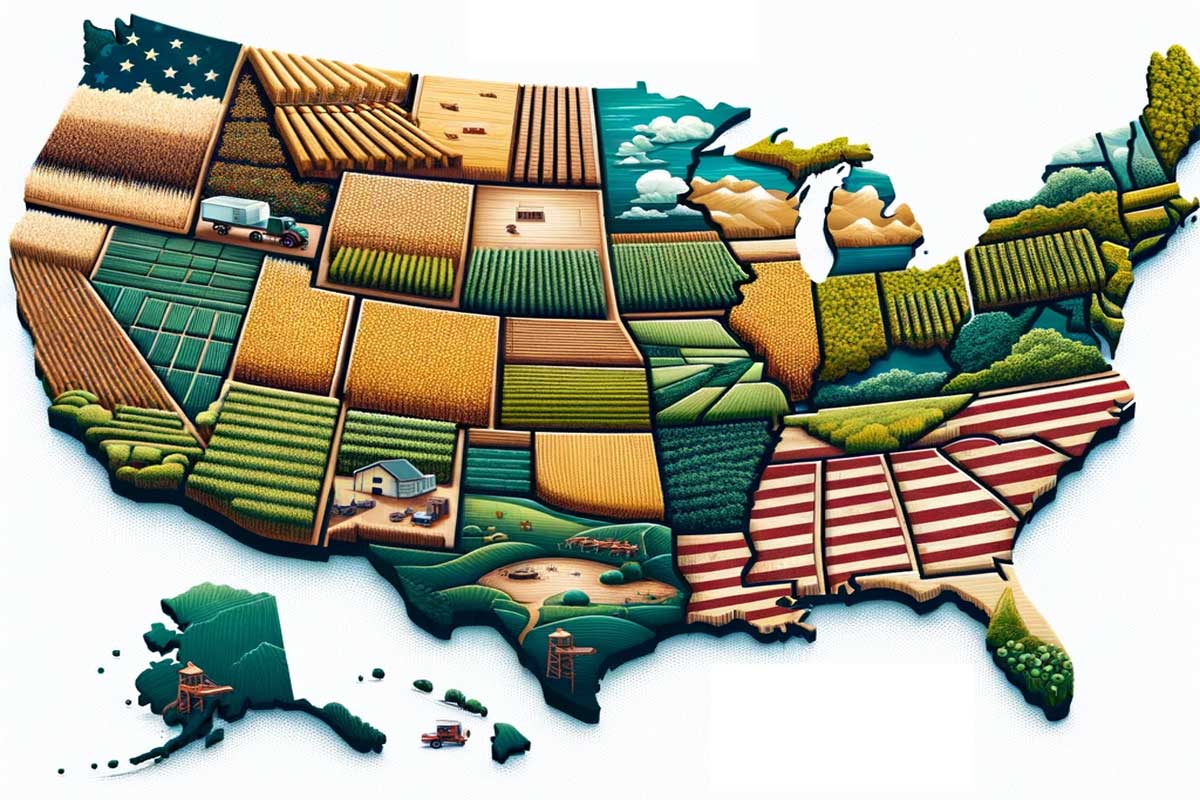According to the USDA, the landscape of American agriculture encompassed approximately 893.4 million acres as of 2022. This represents over 37% of all US acreage of 2.4 billion acres (over 375 million of which is Alaska). This vast expanse highlights the challenges and opportunities of modern farming across the country (Source: USDA). Over 316 million acres are dedicated to crop production, with staple crops like corn, soybeans, and wheat occupying 56.6% of harvested cropland. This heavy focus on a few commodity crops brings noteworthy efficiencies in production through economies of scale, but it also raises valid concerns about biodiversity loss, soil degradation, nutrient runoff, and overall environmental sustainability.
The size and scale of farm operations vary extensively. Large-scale farms over 1,000 acres operate 40.8% of agricultural land and contribute significantly to the national economy (Source: USDA Census of Agriculture). However, these large farms represent only 7.5% of the total number of farms in the U.S., indicating a concentration of land ownership and production capacity in the hands of a relatively few large producers (Source: USDA Census of Agriculture).
Environmental Impacts of Industrial Agriculture
The environmental impacts of industrialized agriculture are substantial. Practices relying heavily on chemical fertilizers, intensive tillage, and prophylactic pesticide use have demonstrable links to issues like soil erosion, water pollution from nutrient runoff, contamination of waterways, greenhouse gas emissions, and loss of biodiversity (Sources: FAO, EPA). Agricultural professionals have an ethical and ecological obligation as stewards of the land to mitigate these impacts through more sustainable practices.
Sustainable Agriculture Solutions
Sustainable agriculture systems such as organic farming, agroforestry, cover cropping, and regenerative practices offer solutions, with their emphasis on soil health, biodiversity, reduced chemical use, and holistic management of farm ecosystems (Source: SARE). Government support through research, incentives, technical assistance, and conservation programs is a pivotal factor in encouraging this transition (Sources: USDA, SARE).
Precision Agriculture
Precision agriculture leverages GPS, wireless sensors, imagery, and predictive data analytics to enable highly targeted, efficient use of inputs like water, fertilizer, and pesticides, leading to increased productivity along with environmental benefits (Sources: USDA ERS, academic journals). Emerging digital technologies like drones, satellites, robotics, and artificial intelligence offer additional ways to monitor crop growth, detect disease or pests early, model weather and climatic patterns, and generally enhance productivity and profitability of farm operations.
Challenges Facing the Industry
Significant challenges persist in the agricultural industry. Climate change leads to extreme weather events like drought, flooding, and heat waves that disrupt crop yields and livestock health (Source: IPCC). Water scarcity in major growing regions compounds these effects of a changing climate. Evolving pest and disease patterns require constant vigilance and adaptation in crop management strategies (Sources: USDA, EPA). Finding ways to boost production to feed a growing global population while minimizing further environmental damage will require a nuanced balancing act.
The Future of Agriculture
A number of steps can be taken to help the agricultural sector address these complex challenges:
Incentivize regenerative and sustainable farming practices through policy and programs to rebuild soil health, sequester carbon, improve water management, and restore biodiversity on farms.
Significantly increase public and private investment into agricultural research on topics like plant breeding, precision agriculture, renewable energy, and climate resiliency.
Create public-private partnerships to facilitate wide-scale adoption of new technologies and practices by farmers through training programs and technical assistance.
Develop market-based solutions that reward sustainable farming practices through eco-labeling programs, carbon markets, and premium pricing for regeneratively grown products.
Successful farming will demand deep expertise in sustainable farming practices, efficient and precise technology integration, soil and water conservation, and whole-farm resource management will only become more vital. The future will likely blend time-honored agricultural knowledge and stewardship with cutting-edge digital technologies to create a more sustainable, resilient, and productive agricultural system .

